The original game did not allow playing in a way that could be seen as realistic, as several crucial aspects were simply missing from gameplay. This led to a comparably simple gameplay where the player could for example choose the train engines simply by their top speed. Both TTDPatch and OpenTTD have since added several features that enhance gameplay and allow playing the game as a kind of virtual model railway instead of simply making money by rushing coal from one end of the map to the other one using insanely fast MagLev trains (although this can be fun just as well).
This page is therefore dedicated to playing the game in a "realistic" way.
What is realism?
The game cannot be realistic (without quotation marks), since it is a game after all. As a game it has to simplify reality to yield a playable result. Some things just cannot be recreated in the game, because of scale issues, because of hardware limitations or simply because the feature is not implemented in the game.
That being said it should be clear that 100 per cent "realism" cannot be achieved in the game. However, the goal is playing in a way that takes real railways as inspiration. That simply means one takes a look at how real railways are operated and tries to simulate this within the limits of the game. Of course, the degree of realism is a matter of taste and varies for every player. Some like to create ultra complex intersections and optimized time tables, other player focus on beautiful scenery and landscape, and then there are those who simply do not care about anything but the income display at the end of each game year. And everyone is right about playing the game his/her own style.
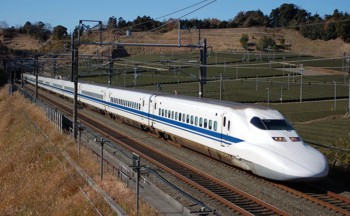
Example: In Japan there are several dedicated high speed tracks for Shinkansen trains. These trains are known to be the first high speed trains in the world, traveling at 200 kph or more since the early 1960s.
One can see from the various possibly style of gameplay that there is no "right" or "wrong" way to play the game. Everything that is described here is only one possible way, one can play in a completely different style and still have lots of fun.
Game settings
There are a bunch of settings that influence gameplay and should be set when playing realistically.
- Realistic acceleration
The physics model in the original game was extremely simple and hence completely unusable for realistic gameplay. A lot of effort has been put into improving this model, and as a result the player is required to think a bit more about how to lay tracks or which engines to buy. It also differentiates more between the strong and slow freight engines and the faster express engines. - Weight multiplier for freight trains
Real freight trains are much longer and heavier compared to the short trains for passenger service. However, this cannot be simulated in the game, since every "freight" (including passengers) have a predefined weight, and the length of trains is somewhat limited. To work around this problem, a weight multiplier has been introduced for everything but passengers. This makes freight trains much heavier, which combined with realistic acceleration has a great influence on gameplay, especially in hilly terrain when a heavy freight train has to crawl up a long sloped track. - Vehicle sets
The original vehicles were neither balanced nor (from today's perspective) graphically pleasing. By now countless vehicle sets have been released, most of them based on real railways from all over the world. The choice is up to the player, depending on the scenario and personal preference. In addition to vehicle sets there are also sets that include new industries and freight types, thus enriching gameplay even more.
A final remark: Using monorail or MagLevs is unrealistic by definition.
Know the real world
Basically, the main principles of real world railway construction also apply to the game. That means one tries:
- to build as inexpensive as possible
- not to level the mountains
- to build only those tracks that are really needed
- upgrades tracks and stations only when increased traffic requires enhancements
- uses overhead wires only where it is useful
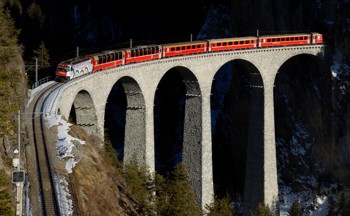
Example: In Switzerland with its difficult topography a number of great engineering feats had to be achieved in order to cross the Alps. The famous Landwasserviadukt is only one of many examples.
Of course there are also railway lines that have been built without any consideration of the terrain. However, one always needs to consider why such lines have been built, and more often than not political or military reasons were the main driving force for railway building. In addition, the traffic structure has been changing drastically since the beginnings of the railway age, causing some lines to become much more important than originally planned, while others were closed as they were not needed anymore.
In short one should try to adhere to the principles outlined above, but if one does not it will work just as well...
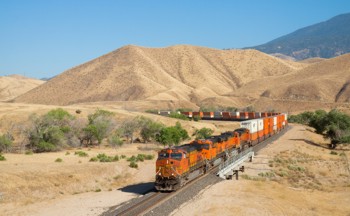
Example: In North America, but also in Australia and other large countries one will find extremely long freight trains being pulled by several engines, with additional helper engines at the back of the train. These tracks are typically not electrified due to the geographic and climatic difficulties for maintenance (just think about what a tornado would do to overhead wires).
The rules above are of course very generic, they have to be adapted to the actual scenario: In North America one uses heavy freight trains, in Europe the rail network is much denser and most lines are electrified. So if you want to play a game in a realistic way you will also need to get at least a basic knowledge about relevant railway history and local peculiarities of the railway system.
Realistic rails
So how does one build realistically? One first step is to take a look at how real railways are laid out. The following table lists some examples of German railway lines. It shows how slope steepness, curvature radius and maximum speed relate to each other. Of course other factors also influence speed, such as the signalling infrastructure.
| Line | Year | Traffic | Speed | Slope | Radius |
|---|---|---|---|---|---|
| Geislinger Steige | 1850 | express, passenger, freight | 70 kph | 22.5‰ | 278m |
| Schwarzwaldbahn | 1873 | passenger, freight | 70 kph | < 20‰ | 300m |
| Frankenwaldrampen | 1885 | express, passenger, freight | 70 kph | 29‰ | 300m |
| Höllentalbahn | 1887 | passenger | 100 kph | 57.1‰ | 200m |
| SFS Hannover-Würzburg | 1991 | express, freight | 280 kph | 12.5‰ | 5100m |
| SFS Köln-Rhein/Main | 2002 | express | 300 kph | 40‰ | 3320m |
So how do these factors correlate? In order to achieve a high top speed, the slopes should be as flat as possible, and the curves should have the largest possible radius. For modern high speed tracks, slope steepness may be higher, since modern trains have much more power.
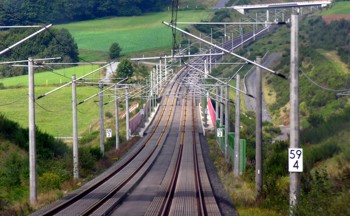
Example: The high speed track from Cologne towards Frankfurt is built with extreme slopes, so it can be used exclusively by the ICE 3 high speed train units.
So what needs to be thought of when laying the tracks? The following paragraphs give some general rules that one can follow. Of course, various compromises will have to be made, for lack of money or missing space. Most of the time, there is not the one optimal solution.
The basic idea is to always keep in mind that there might be expansions in future. That means to leave room for additional tracks or longer station platforms. This also means to perhaps build with larger curves and flatter slopes than actually required. They might be more expensive, but a later reworking might be even more difficult when there are lots of heavy trains running on the tracks.
Curves
Avoid curves if possible. Use large curve radii
A railway line should have as little curves as possible between start and end. The shortest connection between two points is straight - simple as that. And the shorter the line, the more income will be generated by your trains, simply because it reduces the travel times.
If you cannot avoid curves, they should have as little impact on train speed as possible. This means the distance between direction changes needs to be as large as possible.
In the early years smaller curves are acceptable, since trains can only reach comparably low top speeds. For dedicated high speed tracks in later game years the required room for large curves needs to be taken into account.
Slopes
Avoid slopes if possible. Keep slopes as flat as possible
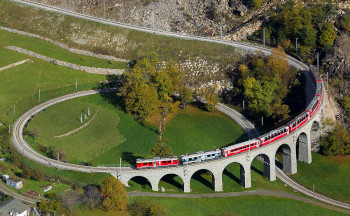
Slopes in the game are much steeper than those of real railways, so they should be avoided at almost any cost. So if start and end of a line are on the same height level, one should avoid height changes in between. Typically it is much more useful to build around a mountain, than having trains to climb across.
There are of course many cases where height differences are not avoidable. In such situations one should always have a number of flat tiles between two slopes. This might not always be easy, it might cost lots of money and be difficult to build, but if a train later on cannot climb the slope a bigger investment is well worth the investment.
As with the real railways, later tracks may have steeper slopes, since stronger engines should be available then.
Bridges and tunnels
Do not build bridges or tunnels as an alibi. Do not build overly long bridges / tunnels.
This basically dismisses all bridges and tunnels that have a length of
two fields, i.e. the bridge heads or tunnel portals are directly
adjacent. Such a bridge does not span over any gap, and two tunnel
portals next to each other are quite useless as well.
A notable exception are the
Enhanced Tunnels
in TTDPatch , which in fact are very useful.
A base tunnel cutting through the whole mountain range might be cool, but it also is extremely expensive, and, above anything else, you cannot put any signals inside. In order to allow as many trains as possible to use long tunnels, one would need several tunnels in parallel, which is even more expensive and more unrealistic. The same problems apply to long bridges. If in doubt, try to build the tracks around a mountain or deep valley, if you can manage that with a few turns and slopes.
For modern high speed tracks more money will be available to build longer tunnels, since the faster trains should not be slowed down by curves and mountain slopes.
Electrification
Build electric tracks only where it is needed. Do not build separate networks.
Since you cannot change engines in the game (trains always have the same engine for the whole line), you will also have to take care to build overhead wires in such a way that the whole line can be changed to electric engines.
In some ways the electric railway network is kind of a rebuilt of the existing network. The original expansion of the network was done by expanding lines branching out from the existing network. With electrification it is the same thing, except that one only needs to build overhead wires instead of a completely new track. Still you always try to branch out from existing electric lines, since you can switch as much traffic as possible to electric traction with as little effort as possible. So if you have built overhead wires in an important station in your network because one line leading there was electrified, the next step would be to upgrade other lines to that station as well. In a similar way one should always try to expand electrification on lines that have already been electrified partly because of another line that uses the same tracks for a certain distance - in such cases you can greatly benefit from electrification with little extra effort.
Junctions / multi-track layouts
Build only what is actually needed. Build double tracked.
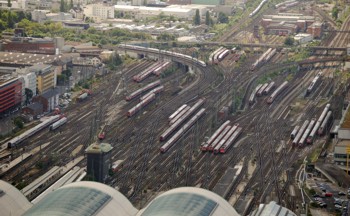
Example: The tracks in front of Frankfurt main station with their countless switches and connections into several directions show how real railway intersections look like (note the ramps leading towards the left and right).
Many players tend towards building complex junctions and crossings which allow going from any direction to any other direction. This is complete overkill and highly unrealistic. Real railways mainly use Y-junctions, where one line splits into two lines, typically near a station. The smaller cases consist just of a number of switches (which can be simulated using path signals), more complex arrangements use short bridges or tunnels to avoid track crossings.
Building only those tracks that are actually needed will also minimize the danger of trains getting lost and causing chaos on the network.
Compared to single tracks, double tracked lines have much more capacity, simply because there is a dedicated track for each direction. This is also the common layout of real railway lines. In special cases with very dense traffic or huge differences in top speed it might be useful to add another track or two, in order to split trains in such a way that slow freight trains do not block faster passenger trains.
On the other hand there are smaller lines with only little traffic which do not need to be double tracked completely. Having a number of passing places, for example in stations with two platforms, is enough for such lines.
Eye candy
When trying to play in realistic ways, the results should also look good. The graphics of the original game do not really allow that, but as there are countless new graphics available, these can and should be used to get improved looks.
Stations
There are countless set with station graphics, especially for industrial stations, containing coal bunkers, grain solos or complex oil pipelines. One should use these possibilities in the game.
Depots
The default depots fill one tile, and that not fully. This is unrealistic, as a long train can enter the depot and just vanish. There are graphics with bigger depots which allow to build multiple depots next to each other to simulate bigger workshop areas.
There also is the possibility to use station sets that look like big depots. You cannot service the trains there, but it would at least look like the train is stopped there for servicing.
With some effort one can even add the service stops to the order list::

With an order list like this (the screenshot is from TTDPatch, but it works the same way in OpenTTD, one can even use the timetable feature to define a waiting time at the depot). The train will stop at the station and unload. This ensures there are no passengers on the train when it goes to the depot for servicing. One could also create a kind of shunting yard where trains will wait for their next journey. Once the train is done with the depot order, it will go back to the station, load and continue to the next station. Having such a depot order in the order list also nicely avoids trains wreaking havoc on the network because they try to enter a random depot because the service interval is expired.
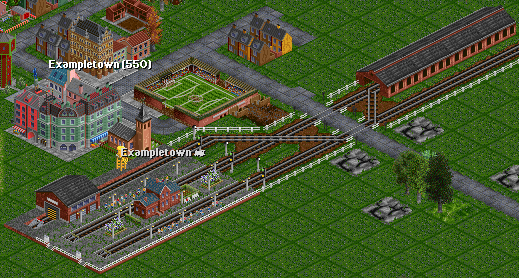
This is what a realistic terminal station on a branch line could look like when using additional graphics sets. There are two platforms for passengers and one for freight, as well as a bigger depot. Do not get confused by the signals, the screenshot is from TTDPatch, signals look a bit different there.
